
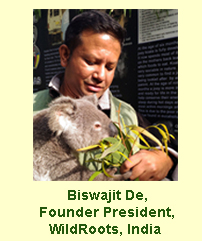
|
WildRoots is for ‘Education & Empowerment’, for ‘Awareness and Positive Energy’. Being ‘eager learners’ at all times, our little initiatives to spread the essential message involves young people, students, communities, institutions and the grassroots. Our initial works are all self-funded, though we have had some patrons supporting us with designs, non-monetary resources, support and encouragement. We are neither trying to become ‘conservation heroes’, nor are we trying to become ‘experts’. Through our work we learn each day and grow. We explore new avenues of expression by learning from the experiences of our seniors and well-wishers and stay updated from the juniors. In the ‘Circle of Life’ – a great responsibility is upon us. We might not be able to save the species that get wiped out from the face of our planet, each moment…but what is the harm in trying? What is the harm in trying to convince our neighbors and say to them – “Please do not cut down the Dead Tree…Coppersmiths have made their nest in it”. Can’t we do ‘this much’…and a little bit more? |
|---|
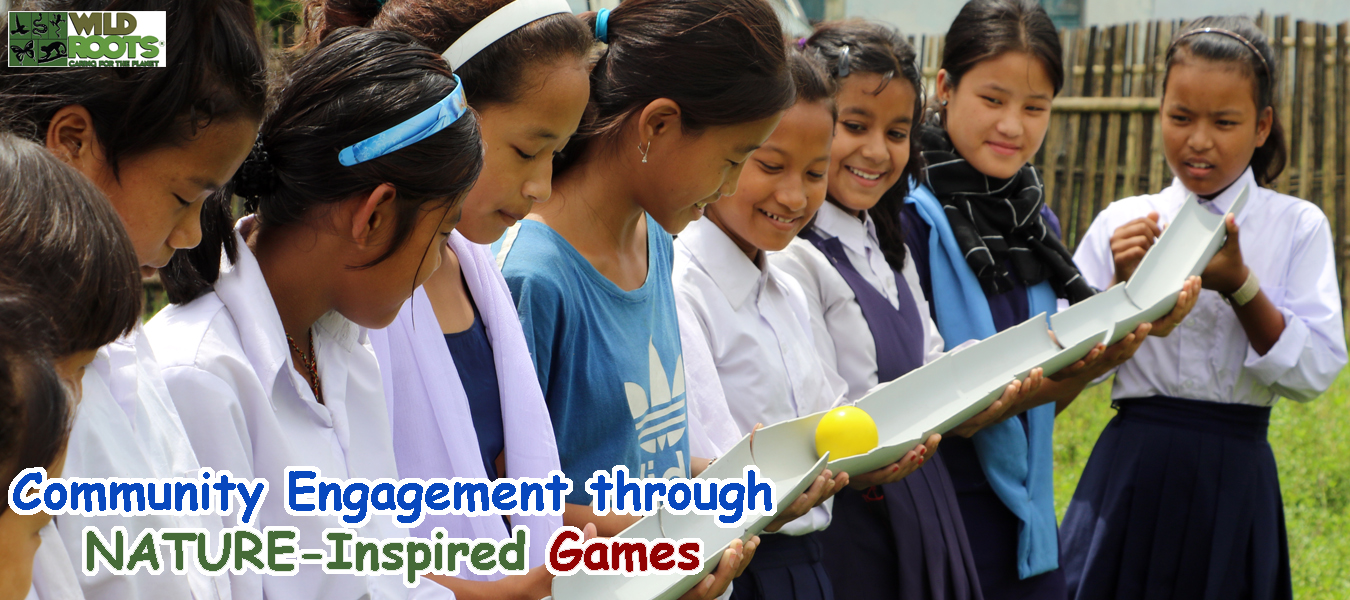
During the year 2015, when we were taking the initial steps towards our Goal of developing a Sustainable Model for our Conservation Education Programmes and Activities in North East India (In the States of Assam, Meghalaya and Arunachal Pradesh), we were introduced to a fantastic resource which was developed by Audubon (in alliance with Toyota), U.S. Fish and Wildlife Service, Environmental Education and Training Partnership (EETAP), TogetherGreen, North American Association for Environmental Education (NAAEE), and many other colleagues, which was designed to better engage people to achieve more Sustainable Conservation results.
A meeting with Judy Braus, who was the Senior Vice President - Education and Centers, National Audubon Society, during our visit to the US, during the year 2015, had laid down the First Foundation for our Conservation Education models, which were also inspired by the IUCN Mandates (when we became a member of the Union) and the UN Sustainable Development Goals. An Educational Trip to the US to attend the Student Climate Corps. & Congress, jointly organised by the US Fish & Wildlife Service and the Green Schools Alliance, equipped us with Directions and Support to further design the pathways, that enabled us to realize a vision - Creating a Sustainable Model by creating the means that would in turn give us opportunities to create a platform where we can have collaborative synergy between Urban & Rural Educational Institutions. Organisational Memberships of reputed organisations like IUCN-CEC, IUCN #NatureForAll had equipped us more to design our programmes, activities and training modules, as we started following their mandates.
As we leant from the Toolkit - Conservation Education demands engagement of People or in other words, Conservation can't happen without people
In coherence with the above learning, we immediately defined our Target - The Student Communities of the Urban & Rural Schools, where, the former sector, which thrived away from Nature and Natural Spaces, has been functioning and working isolated for years, and the latter, which was totally deprived of quality Environment Education, even if being close to Forests and Natural Bio-Geographical areas.
Achieving 'conservation education results' with Educational Institutions, both in the Urban and Rural Sectors, isn’t easy in India. The problems have become increasingly complex and interrelated, over the past years, as two Sectors have hardly met, or have had any prominent interactions. It’s impossible to address most Conservation Education problems with this one-discipline, isolated approach and solutions. We need active input and engagement from a diverse and informed constituency - the question: How can we observe and benefit from the two sectors? We also know that environmental solutions need to integrate social equity and economic prosperity into the equation. Global warming, habitat loss, deforestation, water quality, air pollution, green consumer issues, and almost every other issue extend beyond borders and the solutions require integrated and sophisticated thinking, involving the Student Community, which is most essential in the Indian Scenario. We designed the early blueprints of the programme through these basic steps -
• Assess
1. Define planning purpose and project team
2. Define scope, vision, targets
3. Identify critical threats
4. Analyze the conservation situation
• Plan
1. Develop goals, strategies, assumptions, and objectives
2. Develop monitoring plan
3. Develop operational plan
• Implement
1. Develop work plan and timeline
2. Develop and refine budget
3. Implement plans
• Analyze & Adapt
1. Prepare data for analysis
2. Analyze results
3. Adapt strategic plan
• Share
Crafting the Vision: We conceptualized our Action Plans and designed them as per the following inferences:
1. The Student Community of the Urban Space is more inclined towards Environmental Education and awareness from Books, ICT Tools and other Publications, with engagement in activities which are limited to only the celebration of important Calendar Dates like - Earth Day, Would Environment Day or the International Day of Biological Diversity, where the activities have all become stereotypes, without any follow up, enrichment of Climate, Environmental knowledge and awareness of Biodiversity.
2. The Rural Student Community, who stay close to Natural Spaces, Forests, Glass-lands, etc. have a better understanding of Forest Resources (indigenous knowledge), and can identify diverse species of flora & fauna, being exposed to age old family customs of hunting (sustainable), gathering, use of medicinal plants, use of natural or forest produce, sustainable farming, etc., but lacked resources and exposure to Publications and ICT Tools.
Our Sustainable Action Plan had a vision of bringing together both the student communities under a common Educational Platform, where they could interact and exchange knowledge and information, and collaboratively work together, for a common Goal. The Vision has been realised through the various programmes and projects that we have been able to plan, execute and document, over the past few years. The impacts of those programmes are prominent, profound and far-reaching. Both the communities became our Key Stakeholders to identify and address Local and Global problems. Scopes of discussions were open, and the two started designing Action Plans of their own, which had enough scopes of implementation.
The Collaborative Stakeholders were able to -
• Produce better outcomes or ideas and decisions
• Develop community support for strategies and actions, as well as their decisions and programs
• Uncover important local knowledge about natural resources and biodiversity threats and collectively work on Action Plans, through mutual Resource Sharing.
• Highlight bio-geographical, social and cultural issues and context that influenced the success of their combined projects
• Increase Community (Rural & Urban) understanding of environmental and conservation issues or management decisions in case of Habitat Loss, Animal Trafficking, Poaching, Illegal Hunting, etc.
• Reduce or resolve conflicts between the stakeholders - themselves
• Help successfully implement new programs or policies in the programmes for WildRoots - India
• Create new relationships among the Parents and the adult community and carry forward the learning outcomes
Principal Strategies:
Principal strategies involved -
• designing programmes that explored the ideas and learning outcomes of various nature related activities with the students of Urban Schools in Guwahati, Assam, Kolkata, West Bengal and Raipur, Chattisgarh and then replicating the same model in the context of Rural Schools, particularly the Govt. Schools of Assam, Meghalaya, Arunachal Pradesh and Chattisgarh.
• designing Action Plans which bring the Student Communities from the Rural and Urban Sector together, where mutual knowledge sharing could be facilitated on a common platform.
• connecting with Affiliates like the British Council and facilitate International Environment Education Programmes, where the senior students from Universities could function as Mentors.
• conducting Teacher Training Programmes in both Urban and Rural Schools to empower the Community Educators.
• create opportunities of expression for both teachers and students from participating Educational Institutions and connect ideas through innovative concepts involving Art & Design and teambuilding Nature-based games.
• connecting the Indian Schools and Colleges with that of other countries, like USA and Australia.
Our success with the Urban Student Community had actually answered a question which was placed before us, during the inception of our Programmes - Can a Conservation Education Project for Educational Institutions have Broad Environmental Improvement Goals Instead of Specific Targets (Species-based)?
Yes, some of our projects did not have specific, species or biodiversity targets. But, we wanted to think through what we were trying to do. In the course of our designs and development of the programmes for WildRoots. we were working to strengthen a 'local conservation constituency' comprising of students and teachers from Educational Institutions (Rural & Urban), that will help protect a broad spectrum of biodiversity, or were designing a program that provides people with the 'skills' to get involved in the learning process—an approach that would benefit a number of environmental issues, not just one species or biodiversity target. We were focused on creating a broad societal change (diversifying the conservation movement, integrating environmental education into the existing formal school programming) to help protect the environment in the future and deal with local and global problems that we don’t even know about now.
The difference between these projects and those that are aimed at a specific biodiversity is basically how an organization measures success. Many will focus on people measures. (Did the conservation field become more diverse? Do more people in a community consider themselves part of the environmental movement? Did more people vote for green-leaning candidates? Do more young people understand how to get involved in civic issues when they graduate from secondary and high schools?) There are no clear-cut boundaries, though. As we understood, many projects with conservation targets include strategies that build capacity, educate, engage, and change societal values. However, it was important that we ensured that we have had measurable targets for any project or activities we were working on, even if the end goal is a 'broad environmental improvement' goal.
Approaching the Final Goal:
With the little success stories guiding us, and equipped with the connections that we had established in the Educational Institutes of India, we finally approached our target - Synergy between Urban and Rural Educational Institutions through Environment & Conservation Education. Through the empowerment of Teachers first, when it came to the Rural Schools, through workshops and awareness programmes that involved Action Plan Design and Execution, we were able to create an organized Task Force to disseminate the 'Learning Modules' to the students.
It was time to bring the two together - the Rural and Urban Student Communities. First, there was hesitation from both the Sectors, but since the synergy was approached through Games and Design (Art & Craft), the connection could be established easily and fast. Though it took us about 3 years to establish a common platform of sharing. Knowledge sharing started to happen, dialogues were exchanged, local problems were discussed, collective solutions were thought about, and many wonderful avenues opened up for us. Our approach was simple, targeting what we call as 'bite-sized small goals', which helped us to imbibe in the minds of the participants, the true ethos of collaboration and the need to 'connect'. On one side, we connected the students from the City Schools to the ones that were located in the villages, forest fringes, on the other, we designed Student Internship Programmes for Universities and Colleges, so that we could obtain volunteers for our Community Connection Programmes. The Participating Student Communities followed the same pattern of - Assess, Plan, Implement, Analyze & Adapt & Share, , which they learnt from us, during the Training Sessions that we arranged and organised for them, as an initial step. Equipped with all the training our Mentors have had, we were able to create a 'Student-Led' approach for the execution of our Programmes and Activities. The Results only showed that we were on the right path!
by
Biswajit De,
Founder President: WildRoots-INDIA
#8724058622 | wildroots.guwahati@gmail.com
www.wildrootsindia.in
.jpg)
January, 2019
Location: Chintamoni Kar Bird Sanctuary, Narendrapur, Kolkata, West Bengal.
Presence of Water body near Survey Area: YES
Name of the Water body if YES: Small ponds
Start Point (GPS): Latitude 220 25.6970’N Longitude 880 24.1470’ E
Temperature: 12 °C
Rainfall: No, Light fog
Humidity: 82%
Duration of Survey: 6 hours
Party Size: 07
Team: Chrysalis - SAIE
1. Romit Roy [XI-A]2. Sirsho Duttasharma [XI-A]3. Saptaparna Bagchi [VIII-C]4. Ahana Bhattacharjee [Ex-Student 5. Arani Bhattacharjee [Ex-Student]6. Dipanjan Kar [Ex-Student] 7. Sarbari Karmakar [Teacher] 8. Survey Guide: Biswajit De – Founder President, WildRoots-India.
Checklist of birds spotted during the survey: -
1. Red-vented bulbul
2. Spotted dove
3. White-throated fantail
4. Jungle babbler
5. Fulvous-breasted woodpecker
6. Oriental magpie-robin
7. Rose-ringed parakeet
8. Tailorbird
9. Rufous treepie
10. Asian koel-male
11. Common myna
12. White-throated kingfisher
13. Flowerpecker
14. Asian koel-female
15. Black-winged cuckoo shrike
16. House crow
17. Jungle myna
18. Black-hooded oriole
19. Purple sunbird-male
20. Purple sunbird-female
21. Lesser Coucal
22. Pond herons
23. Verditer flycatcher
24. Red-whiskered bulbul
25. Brown fish owl
26. White-rumped munia
27. Cinereous tit
.jpg)
TESTIMONIALS & EXPERIENCES from Students and Teacher:
On 19th January 2019 we visited the CKBS in Narendrapur as a part of our field trips for the WildRoots Citizen Science Programme. We got to interact with the students of South City International School. Along with taking pictures of birds, we saw a colony of mushrooms, burrow of a water monitor lizard and bird baths. Biswajit Sir showed us ways to do ethical birding. Every activity was fun as well as educational. We waited in front of a bird bath and saw Red vented bulbuls, Red whiskered bulbuls and White rumped munias taking a bath in the water turn by turn. I got some really good pictures from the bird bath. We saw many birds like Black Hooded Oriole, Common tailor bird, Rose Ringed Parakeet, White Breasted Kingfisher, to name just a few. Among the many birds we saw the Cinereous tit and the Black-Winged Cuckoo shrike. I enjoyed the survey and I am really looking forward to more activities. But I was really sorry to know that CKBS has ceased to be a self-sustained forest as it once was. The large-scale pollution, deforestation and urbanization have made the area of this bird sanctuary very small. I intend to raise awareness among people to conserve these forests and sanctuaries as they are most important.
-Saptaparna Bagchi, Class VIII-C.
.jpg)
.jpg)
.jpg)
.jpg)
This was my second experience in a forest survey. When we entered the CKBS it was like entering into a dense, deep forest. The smell of the forest was all around and the whistling sound of the chirping bird made the environment calmer and steadier. We saw there many types of fungus especially bracket fungus. We were very fortunate to have an encounter with a mongoose which was lying on the path where we were heading towards. We also saw a butterfly which was frequently landing on us to absorb the salt from our sweat. When we entered the snake prone zone, we all were alarmed about where we are stepping. We spotted 3 to 4 Water Monitor burrows. The best part about the journey was kneeling down in the middle of the jungle and watching birds taking shower at the bird bath place. This was one of the best forest surveys I have ever attended. It was a great opportunity to learn about the wonders of the nature and cherish such moment of life.
-Dipanjan Kar, [Ex-Student, SAIE]
The survey was conducted on 19th of January, Saturday, 2019. It was conducted from 7.30am to 1.30pm. The survey was conducted under the guidance of Biswajit De sir and Sarbari Karmakar ma’am in collaboration with South City International School. During the course of visit to the site a number of bird species were encountered. They were all spotted either by sight of sound. Many bird species were photographed and their locations were detected using a Global Positioning System device. Most of the bird species were identified on spot. Bird species identifies includes: Red whiskered bulbul, oriental magpie, Rose ringed parakeet, Black hooded oriole, white throated fantail, Red vented bulbul, Jungle babbler, Greater flame back, Purple sunbird. Apart from bird species, various plant species were found. The sanctuary was characterized by variation in temperature and humidity which favors the vegetation growth. The survey gave us an opportunity to identify various species of birds, understand their natural habitat and estimate roughly about the change in number of species found in that particular area. This will help spread awareness of conservation of forest to conserve these species.
-Arani Bhattacharjee, [Ex-student, SAIE]
On the brisk morning of 19th of January, 2019, the survey on birds in Chintamoni Kar Bird Sanctuary was conducted. It was around half past seven in the morning, when we started our survey. The air inside the forest was brimming with the smell of the moist soil and was flooded with the morning light. It was cold but not freezing, it was sunny but not hot. We could intuit the change in temperature from one region to another. We were able to encounter and identify nineteen species of birds, namely Black-hooded Oriole, Magpie Robin, Black Drongo, Jungle Babbler, and White-throated Fantail. We, luckily, also encountered a common mongoose, which crossed our path of survey. We identified two types of fungi. We collected a few samples from it. We were able to hear many calls from different birds, many of which we could not see. We also visited the “snake-prone zone”. It was a perfect environment for snakes to live – filled with bamboo trees, forest floor covered with dry leaves. Towards the end of our survey, around one in the afternoon, we sat in a group near a tub build for the birds to bath and drink water from. After a while, we sat in admiration as we watched the Red-whiskered Bulbul, the White-rumped Munia bath, ignoring the group of twitches watching them. Amidst all, it was really very unsettling to see how much the population of the birds have gone down. Also, the forest was polluted with food packets and wrappers and wires. Few people simply do not understand that because of this pollution they will be able to see much smaller number of birds the next time they visit. It was around three in the afternoon when we headed back home, heavy hearted for we had to leave against our will. It was an astounding, astonishing and awe-inspiring experience. It was my first time on a bird survey, and I am fortunate enough to have such a beautiful experience.
-Ahana Bhattacharjee. [Ex-Student, SAIE]
It’s always been great interacting with different students with various age groups. These interactions always have positive effect on both the sides of teachers and students. And if this interaction is done outside the classroom situation, in nature, and that too with a group of students from another school, the experience is bound to be an awesome one. In brief this was my experience on 19th January, 2019 at Chintamoni Kar Bird Sanctuary.
It’s almost two years that Team Chrysalis of SAIE is working under the guidance of WildRoots for the ‘Citizen Science Programme’. Every survey has been a memorable one with some unique learning experiences for both the students and the teacher. This time also it’s another pleasurable experience that is interaction with some of the students and teaching faculty members of South City International School. Hope this turn out to more informative for both the school’s team members. Looking forward to more such interactions with other schools in future.
-Ms. Sarbari Karmakar, Teacher, SAIE.
.jpg)
.jpg)
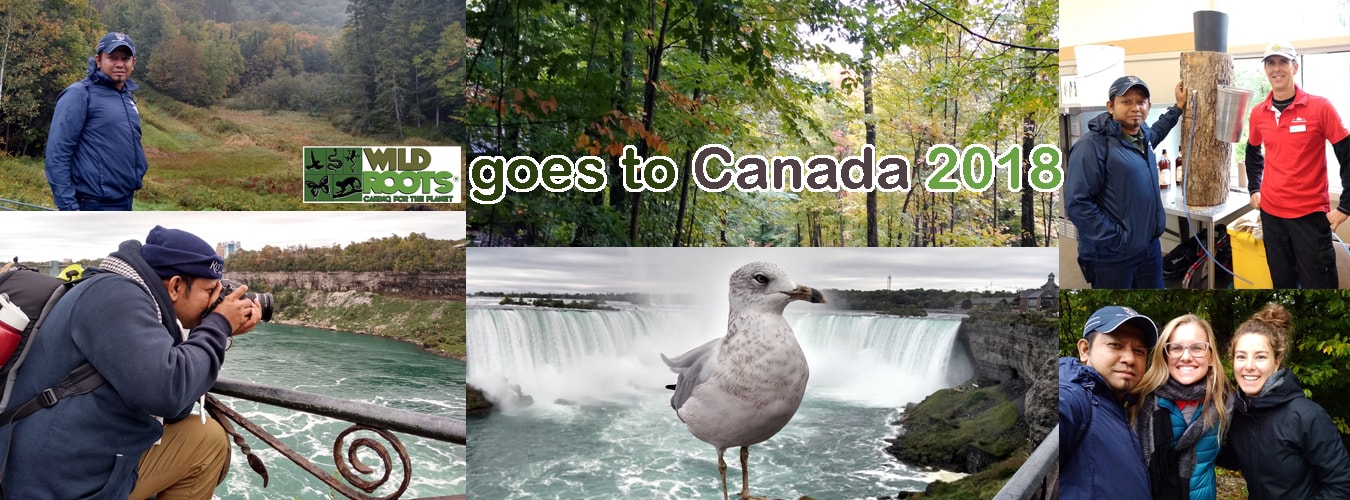
.jpg)
As a part of the Citizen Science Programme on Climate Change, Biodiversity Awareness & Conservation, a Nature Trail and Biodiversity Survey were conducted by the ‘Chrysalis Team’ of Sri Aurobindo Institute of Education (SAIE), Kolkata, West Bengal, to celebrate the Global Tiger Day, 2018, at the A.J.C. Bose Botanical Garden. 34 students, from the school, who have completed the 1st Phase of the Citizen Science Programme, had participated in a 1-day Nature Trail that included a survey-based exploration of the garden using ICT Tools. The Programme was facilitated by the Founder President and Ms Sarbari Karmakar, Teacher of Biology, SAIE, who is also a Content Developer for the Educational Programmes undertaken by WildRoots – India.
.jpg)
.jpg)
.jpg)
.jpg)
The students got a chance to learn about Basic Nature Photography and Biodiversity Survey Techniques. Basic hands-on training on GIS and the use of GPS devices were also provided and the students enjoyed creating the Nature Trail Maps and marking of Waypoints. They also explored various ICT Tools to create Checklists of Species Spotted during the trail.
.jpg)
.jpg)
.jpg)
.jpg)
.jpg)
It is indeed commendable the way the ‘Chrysalis Team’ from SAIE have been actively engaged in all their follow up activities and programmes, being a part of the WildRoots – Citizen Science Programme, and we hope that they continue their wonderful journey with us and give us an opportunity to learn more. The Students have taken some great photographs during the event and we will be sharing them in our Gallery Section soon. Also, the checklist of Birds spotted and photographed during the survey will be shared soon.
-- A Big Shout Out for Team Chrysalis – SAIE, Kolkata!
As a part of the Citizen Science Programme on Climate Change, Biodiversity Awareness & Conservation, a brief Media Training Session was conducted by the Founder President at Shri Shikshayatan College, Kolkata during the months of June-July, 2018. 12 students, from different streams of study, who have completed the 1st Phase of the Citizen Science Programme, had participated in a 3-day training session on the Basics of Documentary Filmmaking and Reporting. The session was divided into indoor/classroom training on the use of different types of Cameras and Audio-Visual Equipment and outdoor shooting session at the Rabindra Sarovar Lake, South Kolkata.




The students got a chance to learn about Basic Cinematography and Pre-Production through simple exercises on Script-writing, Pre-Production and Storyboarding. Example Documentary Films were screened during the introductory session to familiarize the students about different types of Camera Shots, Camera Moves, Transitions, Use of Light in Filmography, etc.






The Students were taught the use of proprietary Video Editing Software – Sony Vegas, where Evaluation/Trail Versions of the Software was used to impart the training. They came up with scripts of their own and got a chance to learn the use of Audio Editing Features of the Software to record their own narrations for 3 min short films which they shot and edited. For most of them, this was the First time that they were trying to make a film.








Outdoor Shoot at Rabindra Sarovar Lake –






International Dimension –


The Media Training Session attained an International Dimension with the participation of Ariel Gans, Student from the University of California, Berkeley, who came over an interacted with the student participants and shared her own work related to Environmental Awareness and Conservation. A friend of the Founder President, who met her during his training at the National Conservation Training Center, West Virginia, US. Ariel was invited by him to join the programme and participate in the outdoor shooting sessions. WildRoots is really grateful to her and commends the way she interacted with the students, sharing her ideas. She, along with one of her fellow interns who had been to Kolkata, working at the Tata Medical Center, were interviewed during the outdoor shooting session, where they shared more about the conservation measures that are taken in the US, and some simple ideas that can easily be replicated in the Indian scenario, to combat Global issues and work for a collective outcome.






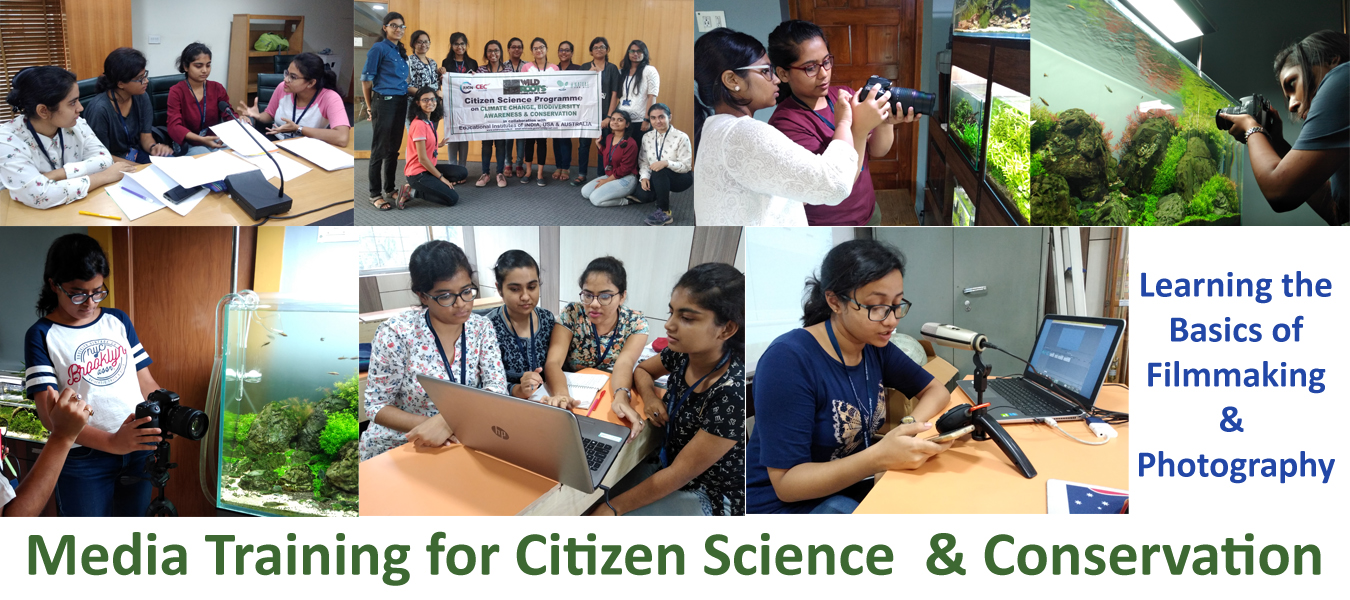

'Art for Conservation' meets Poetry & Regional Content at the BNHS Vulture Research, Breeding & Conservation Center at Rani, Assam on 8th of April, 2018.


We were privileged and proud to have with us Mrs. Padmakshi Patowary, Poet and Bird Lover from Guwahati, Assam who has written a wonderful Book on Birds of Assam - 'AHA SUNO PAKHIR KHOBOR' which has over 100 poems on different Bird Species. This is the First compilation of its kind in the Regional Assamese Language, which gives out information on the Birds to children, in the poem format.Thanks to Sachin Ranade Sir and Sonali Ranade Ma'am for making this happen and to give WildRoots an opportunity to connect the poet to the children of the villages. The fun-filled day spent at the center were comprised of Padmakshi Patowary reciting some of her own poems, which gladdened everyone's hearts. The children were more than enthusiastic to show their scribbles of Birds to us and even recited some of the poems from the Book. The children were thrilled to get a copy of the book right from the poet herself.




At WildRoots, it is our constant effort to engage the children and the youth through interesting means of engagement such as Art, Literature and Storytelling, and if we have Super Mentors like Padmakhi Di, Sachin Sir and Sonali Ma'am...we are surely going to succeed, for we have the actual stepping stones in front of us. All we have to do is take our steps carefully and reach out to the community.


WildRoots is working on the design of contents based on Bio-diversity Awareness and Conservation in the Regional Languages as well as English, where the content is being developed by the student members of WildRoots.
We are progressing in small leaps and bounds...and we are enjoying the journey.
#NatureforAll

Recently, WildRoots organized a 'Conservation Education Camp' at the Pakke Tiger Reserve, Seijosa, Arunachal Pradesh, India with 10 student Participants and 1 Faculty from Sanskriti the Gurukul, Guwahati, Assam, India in collaboration with the Ghora Abhe Society, Seijosa and the local communities.


Following was the Programme Content of the 3 Day Camp:
Day-1 - Arrival and activities in nearby area of the Camp - Evening River Walk and Warm Up Excercises, Evening Introductory Presentations & Slide Shows
Day -2 - Birding & Bio-Diversity walk, interaction with Govt. school children with Community Connection Programmes. Interaction with the staffs of WTI, NCF, Pakke Tiger Reserve (PTR) in their office-Programmes at the PTR Interpretation Centre. Students will learn the Construction of bamboo/rope(cane ) fencing ,i.e. a)Kitchen garden, b) Jhum farming fencing
Student Presentations on Learning Outcomes in the Evening
Day -3- Birding, trekking, observation of Hornbills and interaction with Hornbill Nest Protectors and Ghora Aabhe Society members (discussion on conservation initiatives from the perspective of Indigenous Communities), experience preparation of local foods/recipes in the village located within the Pakke Tiger Reserve. Additional Activities to be planned - : a)collection of medicinal plants sapling from the jungle b)preparation of pit for plantation of medicinal plan. c) plantations d) briefing on about the utility of medicinal plants planted, etc.
Student Presentations on Learning Outcomes in the Evening
Day -4: Reflections and Departure




Students also got a chance to do an Avian Survey at the Pakke Tiger Reserve and observe the nests of the Hornbills. A total of 38 Bird Species were spotted and photographed by the students. The Checklist was uploaded on eBird by the students with guidance from WildRoots. Interaction with students of small Govt. Schools which are located in the Forest Fringes also constituted the 3 Day programme where the Students from the City Schools were able to connect with the Students from the Govt. Schools and learnt how to come up with collective solutions related to Conservation.




Complete Checklist of Birds Spotted during the event along with some of the shots taken by the participants.
Community Connection & Interaction Activities form an integral part of our programmes where we try to bridge a gap between big city schools and small Govt. schools which are located near and far from the forests. Through workshops and interactive games, the students from the schools learn how to connect and build up ideas to work for a productive and sustainable outcome.




To imbibe the true ethos of Conservation in the minds of the students, Community Connection is most essential and when it comes to Conservation, a collective Task-Force of City Schools and Small Govt. Schools would be the most effective in identifying and observing the Local and Global issues and work together for a collective outcome.



We were humbled by the DFO, Pakke Tiger Reserve, who came over and had an interaction with the participants and shared some wonderful stories about his own life in the Forests and work related to Conservation of the Hornbills and other Wild Life of Pakke. He then handed over the Participation Certificates to the students. The students gifted him Artworks which they have made during their stay at Seijosa.






WildRoots would be back to Pakke Tiger Reserve, Arunachal Pradesh with more such enterprising programmes that generate strong learning outcomes, and help us connect the students with Nature!
We are grateful to Mr. Suresh Pait, Teacher of Govt. School, Seijosa and owner of the Mubuso-2 Camp for his immense support and cooperation, Ms. Nandini Velho, Earth Institute Fellow, Columbia University for organizing all of the interactive sessions for the students and Mr. Tana Tapi, Divisional Forest Officer, Forest Department - Pakke Tiger Reserve for supporting the
Conservation Education & Nature Camp – 2018!
.jpg)
Excellent Follow-Up Survey and Documentation Activities were organized recently by team - "Chrysalis", a group of dynamic teachers and students from Sri Aurobindo Institute of Education, Saltlake, Kolkata, West Bengal. A half day survey at the Chintamani Kar Bird Sanctuary (CKBS) within the City of Kolkata yielded a plethora of flora and fauna which were recorded using scientific methods. The Programme was conducted by WildRoots as a next phase to the Citizen Science Programme which was initiated last year with 5 Schools from Kolkata and has emerged out to be a successful initiative taken by the organization which generated strong learning outcomes.
List of the students who participated in the field trip:
1. Arundhuti Ganguly (X-C)
2. Ishita Chakraborty (X-A)
3. Romit Roy (X-B)
4. Sirsha Dattasarma (X-B)
5. Sneha Maulik (XI-Science)
6. Suvechha Mukherjee (XI-Science)
7. Chandrojjoy Roy (XI-Science)
8. Ujan Banerjee (XI-Science)
9. Manami Das (XII-Commerce)
10. Srijita Banerjee (XII-Humanities)
The Citizen Science Programme is being coordinated by Ms Sarbari Karmakar, Teacher of Biology, SAIE and is being supported by Mrs. Debleena Bhattacharya, Principal of SAIE. As a part of the Follow-Up activities, the team also put up an exhibition of their learning outcomes in the form of a Display Board in their School.
.jpg)
Following are the photo-documentation of the programmes:
.jpg)
.jpg)
.jpg)
.jpg)
.jpg)
.jpg)
.jpg)
.jpg)
.jpg)
.jpg)
.jpg)
.jpg)
.jpg)
.jpg)
.jpg)
.jpg)
The Purple Rumped Sunbird gladdened the hearts of the three observers who were constantly watching it, sitting beside a window which opened right beside a large hibiscus tree. As said by two local kids, this bird is a resident bird of that particular area and comes to forage daily. After observing it on 12th August, 2017 a second try was made on the 14th in order to reassure that this bird tends to come in daily foraging on the nectar from the various kinds of flowers which the residents of Meherpur, Silchar, Assam, planted as their love for nature is immense.
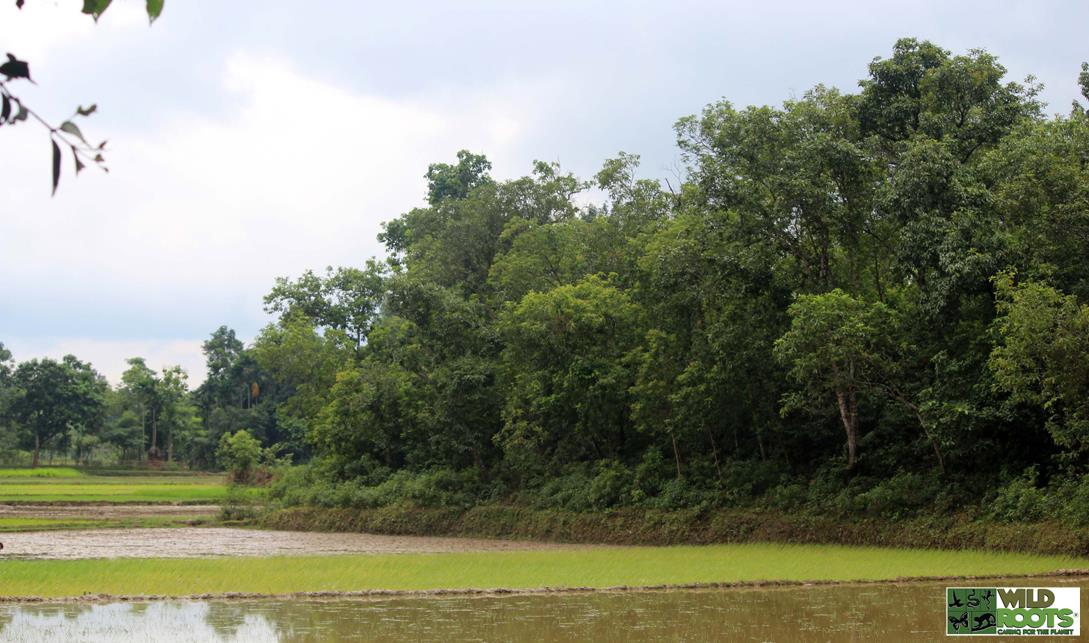
Some parts of this particular area consists of untouched land which has a large variety of vegetation, thus creating a small bio-diversity hot-spot which has created homes to many birds and animals.
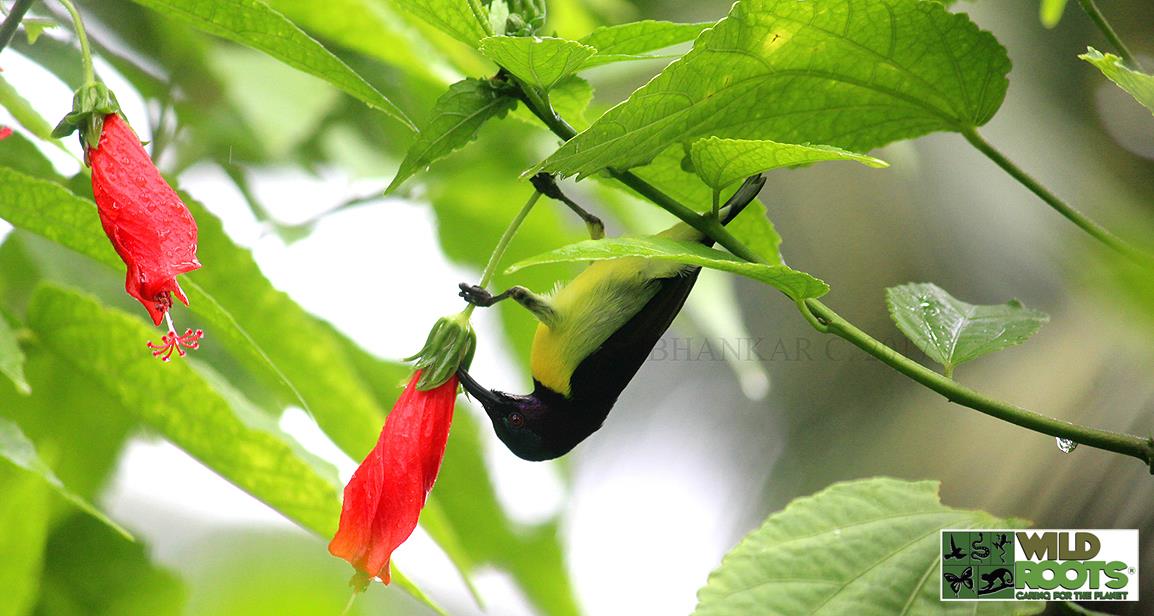
As said by some local observers these birds are a daily treat to their eyes. I, Subhankar Chakraborty, an active member of WildRoots had a different experience while observing these birds and animals. It was interesting to know that the local community have now taken in great interest and regularly observe and photograph the birds and the butterflies, found in this region.
Apart from the Purple Rumped which was a lifer for me and also a 'star' of this trip. Some other Birds spotted during this trip includes -
-Asian Pied Starling
-Chestnut Tailed Starling
-Asian Pond Heron
-Chestnut Munia
-Red Vented Bulbul
-Common Mynah
-Oriental Magpie Robin
-Common Tailor Bird.
-Black Drongo
-White Breasted kingfisher
-Indian Roller
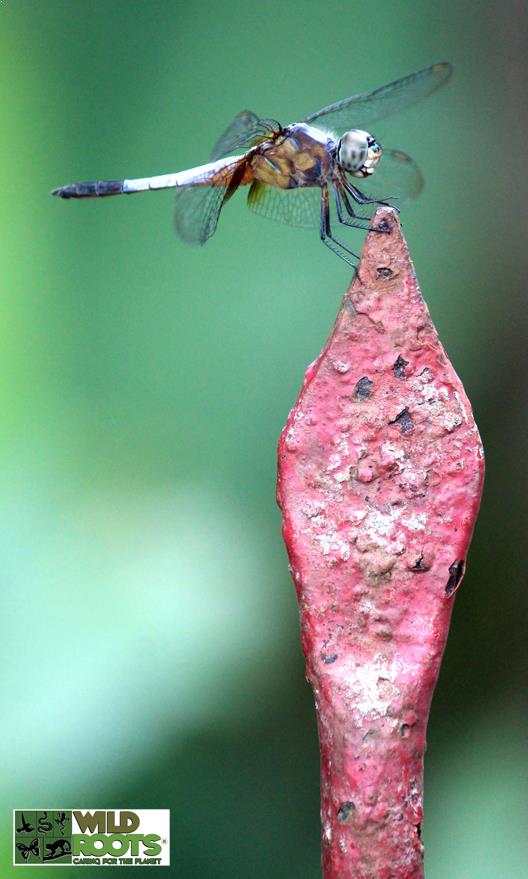
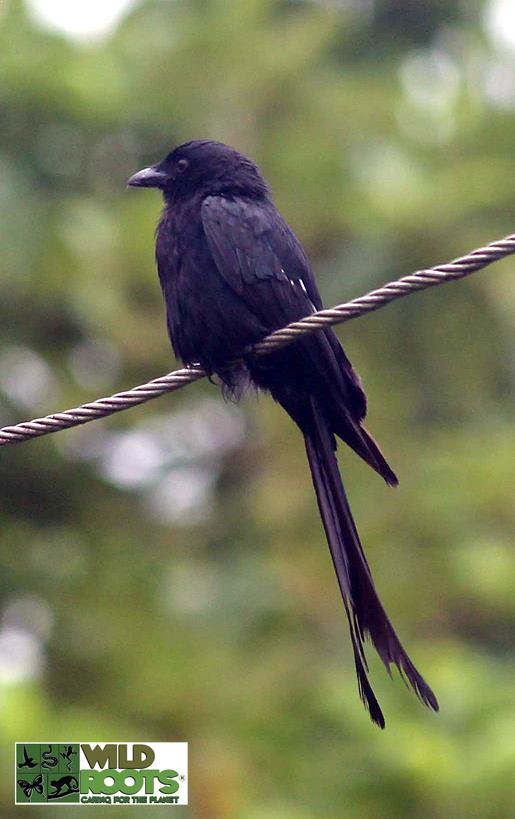
Moving away 110 km towards the Bangladesh border resides a village known as Duttagram nearer to a small Station town named NILAM BAZAR . The place also consists of some of some good spots for Birding, but due to immense rainfall hardly any birding was possible on the 13th August, 2017. But what great was observed upon a hilly mass of land which was actually about to be used for some commercial plantations, the owner decided to leave it untouched since last 30-40 years thus creating a natural Eco-Habitat within his own land.
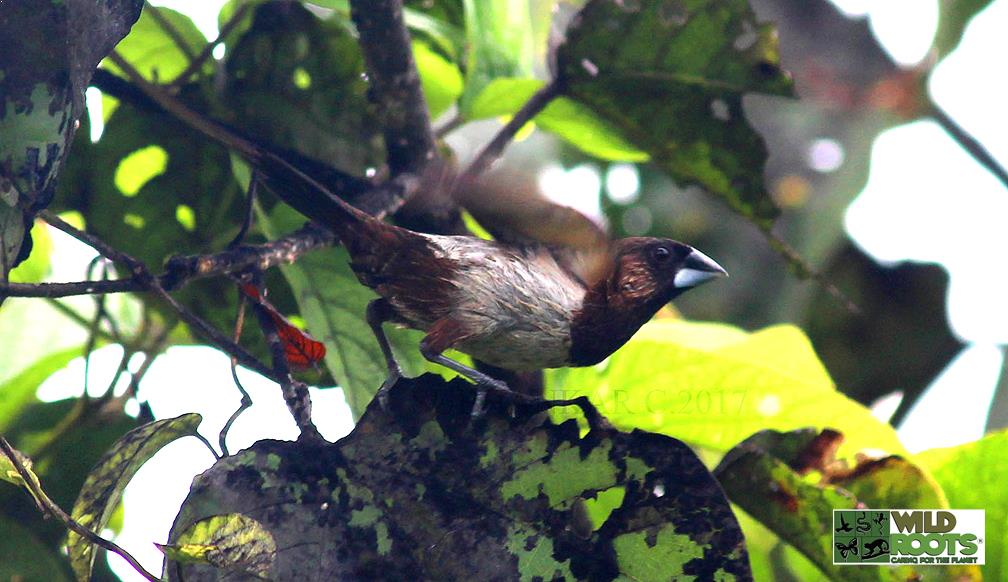
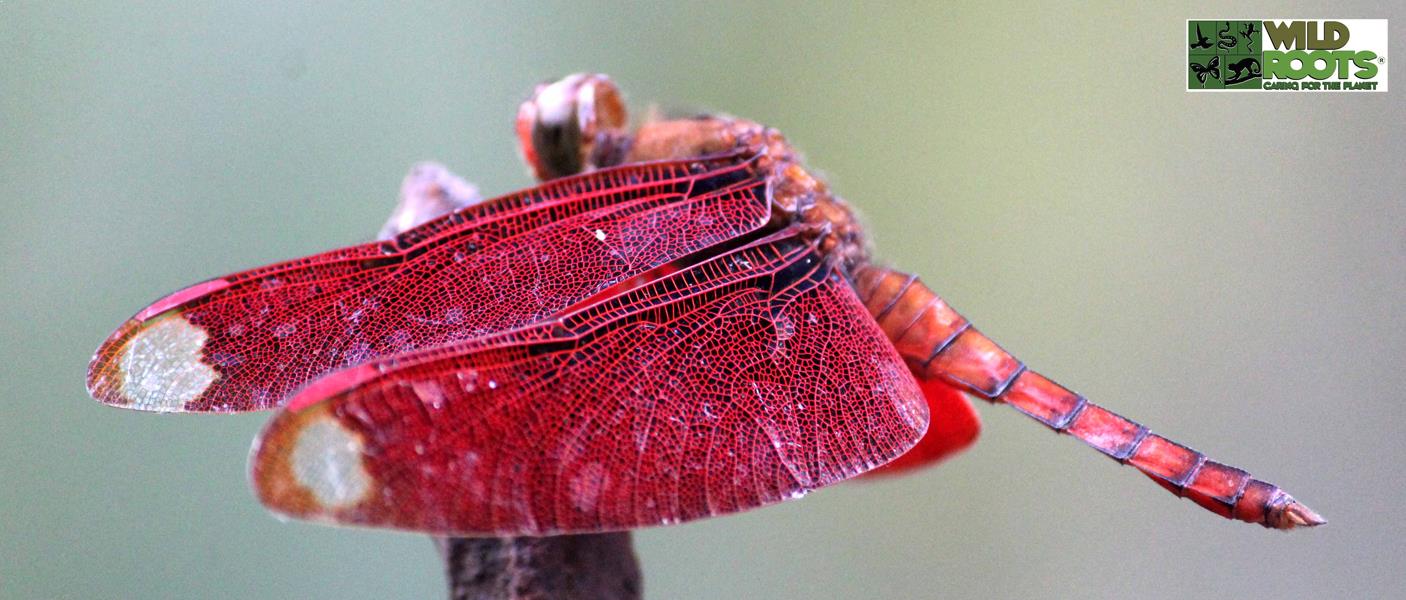
The land, around 2-3 acres holds more than 80 species of birds, Dragon flies and Butterflies. But yet again due to bad weather condition the cameras couldn't be used and no images could be taken. But, this gave me an opportunity to see the plethora of species found in the region, with my own eyes.
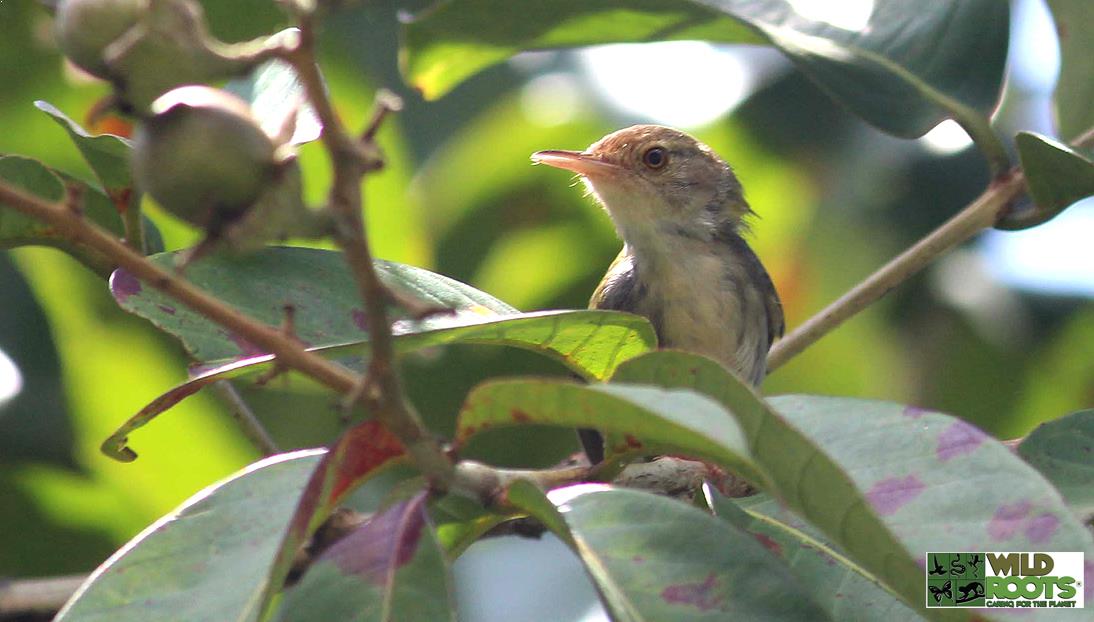
Some of the Birds that I found here were.
-Scarlet-backed Flower pecker
-Common Tailor Bird
-Common Kingfisher
-Pond Heron
-Indian Roller.
-Barn Swallow
-Black Drongo
Sharing some images that were taken by me. I have also submitted the info of the Purple Rumped Sunbird to e-bird portal and a checklist will soon be shared with all. WildRoots has played a very important role in connecting me with Nature and in giving me opportunities to explore the bounties of nature, about which I was so ignorant before.
Subhankar Chakraborty,
Member,
Wildroots India.
Our programme through which we give an opportunity to the student community to explore the flying mammals through 'Citizen Science, Action Research & Sharing of Information'.
.jpg)
.jpg)
Our 1st Activity-based Programme on 'Bat observation, Student Action Research and Citizen Science' began today in Guwahati, Assam, India where students of Sanskriti the Gurukul - Dept. of Environment Science and St. Stephens School observed the roosts of the Indian Flying Fox (Pteropus giganteus) - or the Indian Fruit Bats around Panbazaar, Pani Tanki Area. Engaging two very focused groups from both the schools, the WildRoots – Batwatch was conducted by the Founder President which also involved 'Bat-Art' - Observing the Bats and creating some art for conservation, distribution of Origami Bats to general public, which had slogans and information about bats and Field Survey to record observations and behavior of the Bats, which constituted the 4 hour programme.
.jpg)
.jpg)
We are indeed happy to connect the school students to the Bats and generate awareness about the Ecological Importance of the Bats, the important role that they play in pollination and dispersal of seeds, and even clear some misconceptions about Bats, in general. Leaving some protected areas, the main threat to the Fruit Bat species is ‘habitat losses’. As uncontrolled ‘Urbanization’ takes its heavy toll on trees, the Bats are losing their roosts, their habitats. It is important that awareness is generated at the earliest among the community at large about the importance of these ‘sentinels of night’ busy in controlling insects like mosquitos or aiding pollination of many fruits and in the dispersal of seeds.
Bats are less understood, less talked about, misunderstood, feared and hated by humans. In other ways, they are considered as a ‘delicacy’ in some indigenous communities of India which raises many questions about the conservation of the species. We are not trying to address a thousand year old custom or practice and inspire the student community to orchestrate a movement against those communities. There is always an opportunity to connect with the students of those indigenous communities, spread the awareness and make them understand the importance of the Bats. Through its little initiatives and programmes WildRoots will always try to connect the student communities of the rural and urban and facilitate an exchange of information.
.jpg)
.jpg)
.jpg)
For the Batwatch programme, the wonderful students of Sanskriti the Gurukul came up with a brilliant idea of making Origami Bats and distributing them to the people, during their ‘Bat-Walk’. The Origami Bats had messages and information on Bats. Awareness indeed becomes interesting and innovative if spread in the most creative ways, through Art & Design. Some of these ‘Bat-Origami’ were also shared with the students of St. Stephens. During their observation the students counted about 450-500 Fruit Bats. The students were also introduced to Photographic Equipment like High-End Digital SLR cameras and Telephoto Lenses and Optical Instruments like Binoculars. Through the ‘lenses’, the students got to observe the behaviour of the Bats, up close.
.jpg)
.jpg)
.jpg)
Basic composition techniques in Photography, ethics of Nature Photography and ways of using Photography as an effective conservation tool were also discussed with the students. The shots that they took of the Fruit Bats were amazing.
.jpg)
.jpg)
.jpg)
.jpg)
Following are some of the Photographs that were taken by the students during the ‘Batwatch’ Programme:
.jpg)
.jpg)
.jpg)
.jpg)
Hope that our little initiative will create a stir in the hearts of the young generation and they would be able to understand the negative effects of deforestation and ‘man-made’ habitat loss. We have started small...hope to go a long way with the support of our friends, patrons and well-wishers.
Special thanks to Ruchi Rai Sharma (Sanskriti the Gurukul) & Olivia W Marchand (St.Stephens School) for facilitating the programme and encouraging us. #SavetheBats
A total of 36 Birds were spotted and documented at the Amchang WLS, Guwahati, Assam by the students of Sanskriti the Gurukul School. The Birding hike from the side of Brahmaputra Jungle Resort was both fun-filled and exciting as our 'junior explorers' did a fine job in noting down the scientific names and coordinates to mark their spottings. A small session was organized with the students explaining them about EBirds and creation of checklists, where their observation was recorded and posted Online. Students also got a chance to use ICT - Information & Communication Technology Tools in the form of Mobile Phone Applications and Apps on Apple Tabs which helped them identify the different Bird species that were spotted at Amchang.
The team started their survey at Amchang at around 7 AM and was almost immediately greeted by regular species of Birds like the Spotted Dove, Asian Pied Starling, Chestnut tailed Starling, etc. The team was delighted to find the Scarlet-backed Flowerpecker and the Green-billed Malkoha when they explored the hillocks. The cacophony of the Racket-Tailed Drongos and the Hill Mynas left them awestruck at the plethora of Avian species that were 'lifers' for most of the students who participated in the Bird Count.Thanks to Ruchi Rai Sharma, teacher, Environmental Science & Biology of Sanskiti the Gurukul and Member/Content Developer of WildRoots-India for facilitating the event and Migom Sarma, proprietor, Brahmaputra Jungle Resort to arrange for the Guide, necessary permissions and refreshments for the participants.
We strongly believe that our little efforts will be carried forward in future by the enthusiastic student participants who will constitute the organized task force to combat global issues like Climate Change and Habitat Loss. Our job is only to inspire and induce the love for nature in these young minds. So far we have experienced success...for the sparkle in the eyes of the students when they spot a bird...is actually the spark of our success.
The Checklist can be found at - http://ebird.org/ebird/view/checklist/S34493168
This write-up appears on our Private Facebook Group: https://www.facebook.com/groups/1402798476623326/

Sutirtha Lahiri, Assistant Secretary, Wild Roots, India had conducted an Avian Awareness Camp on Urban Avifauna of Guwahati & the Need for Conservation at Maria’s Public School, Guwahati, Assam, during 2014. This presentation was a part of an International Collaborative Project under the British Council International School Awards Programme which was based on the Conservation of Birds.
During the camp, Sutirtha had interacted with the students of the senior secondary section and had encouraged them into activities relating to conservation. He had shared his own experiences about his own Birding Treks and Hikes in the hills within the city of Guwahati. The Students were encouraged further to see his amazing photographs of birds. The Camp was an essential addition to the International Projects that were undertaken by the school and had helped the institution is getting the prestigious International School Award from the British Council, during the year 2014.

During a survey done by WildRoots at various locations within the city of Guwahati had revealed the presence of as many as 155 Bird Species, spotted and photographed during just a day’s Birding Event. Media coverage about the Avian Survey- http://www.telegraphindia.com/1140310/jsp/northeast/story_18064415.jsp#.VvVHa-IrKM8
It is always challenging to organize a programme like the ‘Sanctuaryasia Kids for Tigers’ at a rural school such as the Karara HS School at Baihata. But, we found students who could connect more with the Forests and Biodiversity, unlike the students of the Urban big schools. We found enthusiasm, cheerfulness, even if infrastructure was absent. We found students who knew the names of every bird, reptiles & amphibians that are found in the region. We found eagerness to learn, eagerness to know, eagerness to question. The Sanctuaryasia Kids for Tigers programme was executed by the Secretary and the Student Members of WildRoots. WildRoots is one of the Programme Coordinators for the Sanctuaryasia Kids for Tigers Programme in the State of Assam. Though we struggled with basic power supply, classroom walls unsuitable for putting up banners and posters, we got smiles, encouragement, curiosity...and more. This was the first time that students from a rural school was encouraged into activities related to Tiger Conservation, which is important for the State of Assam.
News & Articles about the Tigers of Assam:
-- http://www.thehindu.com/sci-tech/energy-and-environment/kaziranga-has-over-100-tigers/article3370293.ece
-- http://timesofindia.indiatimes.com/city/guwahati/Camera-traps-spot-118-tigers-in-Kaziranga/articleshow/12940380.cms
.jpg)
.jpg)
.jpg)
.jpg)
.jpg)
.jpg)
.jpg)
.jpg)
.jpg)
.jpg)
.jpg)
WildRoots, in association with Karara Kendriya Chatra Sanstha had organized an Avian Awareness & Conservation Programme at the Bidhia Aanchalik High School at Karara, Baihata Chariali, Assam. This was a part of the Community Education Module under the various Educational Programmes that the organization had started in the State of Assam, India.
During the programme, the students of the school were shown slides on common birds found in Assam and were taught simple identification techniques, which anyone can use to identify the Birds that we see around us. The students also got a chance to have hands-on training about Avian Photography and learnt the use of Cameras and Lenses. The Programme will be followed up by Photography Workshops in future and Birding Treks will be arranged for imparting more knowledge about the Birds.

.jpg)
.jpg)
.jpg)
.jpg)
.jpg)
.jpg)
.jpg)
.jpg)
.jpg)
“To conserve and protect birds, one does not need to be an expert. To tell the people of your community…not to kill birds, all it requires is an initiative to educate and spread awareness.”
- The Programme was based on the above vision!
News & Articles about the Avian Awareness & Conservation Programme:
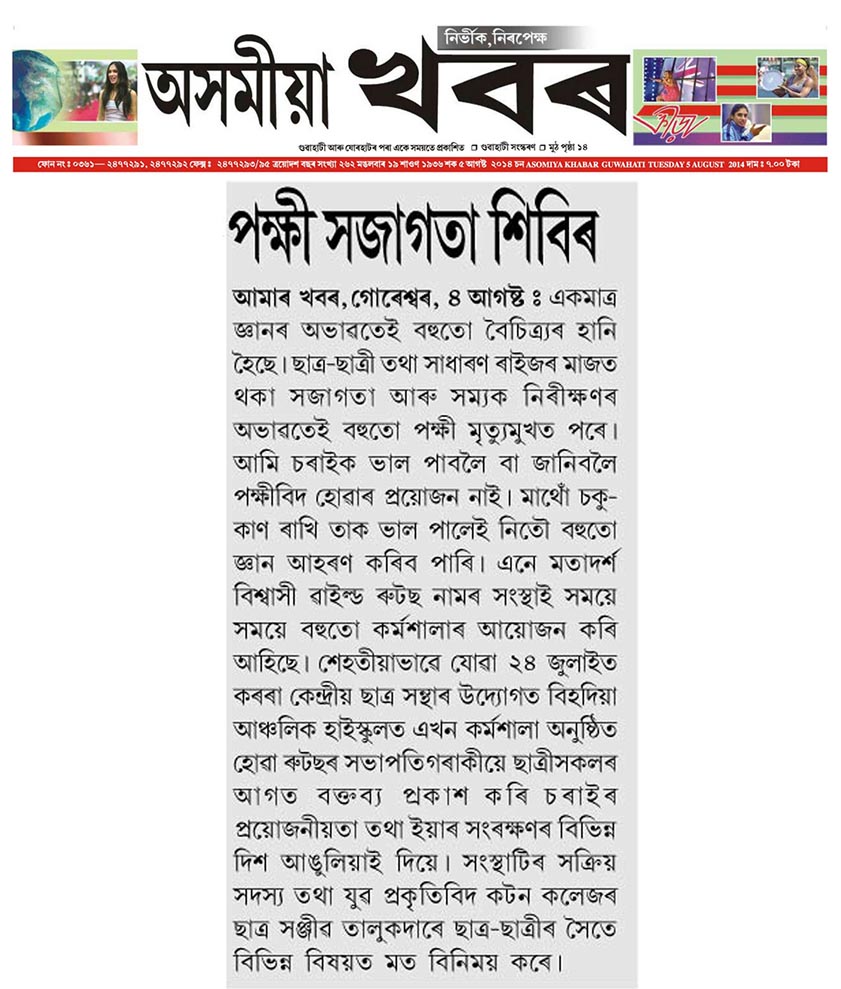
The Media Report!
“Earth Day commemorations now take place all across India,” said Earth Day Network (EDN) Country Director, India, Karuna Singh. “This year marks the 45th anniversary of Earth Day, and our programs will focus on the global Earth Day slogan ‘It’s Our Turn to Lead,’™ Our endeavor will be for a Green India.” In many cities of India, Earth Day Network Indian has launched the शहर GREEN करो - It's Our Turn to Lead™. The campaign encourages citizens to compete toward making their city “Swachh” (clean) and “Green”, participate in various activities that adds to the official celebration of the Earth Day on 22nd of April, 2015.
The EDN Campaign was launched in Cotton College by EDN Programme Coordinator from Assam, Mr.Biswajit De, the Founder President of “WildRoots”- A Society for Environment Education, Biodiversity Awareness & Conservation. Sanjib Talukdar, B.Sc. Botany, Secretary - WildRoots, had been the principal student coordinator for the event in association with the National Service Scheme (NSS) – Cotton College Unit, who encouraged his peers and had mobilized the students into various activities based on ‘Sustainability, Environment, Biodiversity Awareness & Conservation. The Programme was inaugurated by Dr. Nirada Devi, honourable Principal, Cotton College and the celebration had started off with a special presentation lecture by Dr. Pradip Sarmah, Associate Professor, Dept. of Geography, Cotton College. Students had participated in a Poster Competition on “Go-Green…Model for a Green Campus” and a Youth Panel Discussion on various environmental issues and crises of the present times. Present during the celebration were Mr. Sunil Kr. Basumatary, NSS Regional Head, Mr. Nur Islam Saikia, Programme Coordinator/Associate Professor, Dept. of Assamese, Mr. Dilip Rajbongshi, Programme Officer, NSS and Ms Sewali Kalita, Journalist, DDK Guwahati, who encouraged the students and have expressed their strong desire to support future activities and programmes, to be undertaken by Cotton College, in the State of Assam.
 copy.jpg)
 copy.jpg)
 copy.jpg)
 copy.jpg)
 copy.jpg)
 copy.jpg)
 copy.jpg)
 copy.jpg)
 copy.jpg)
 copy.jpg)
 copy.jpg)
 copy.jpg)
 copy.jpg)
 copy.jpg)
 copy.jpg)


'Thermocol Polystyrene Plates left behind in the Water Bodies where the Rhinos bath, the Migratory Birds feed....Blaring Speakers as merry picnickers do everything that drives away the Birds and other Wild Animals....Bottles floating everywhere, some broken to pieces.....Irresponsible Acts of the Humans that poses a threat to the Wild Life Sanctuaries and the Forests all over India'-
How can we possibly solve this problem? Can PICNICs be avoided in these locations at all?
What are the EXPERTS saying about this? Sanjib Talukdar, Secretery, WildRoots had been to the Pabitora WildLife Sanctuary to observe and document.
.jpg)
.jpg)
.jpg)
.jpg)
.jpg)
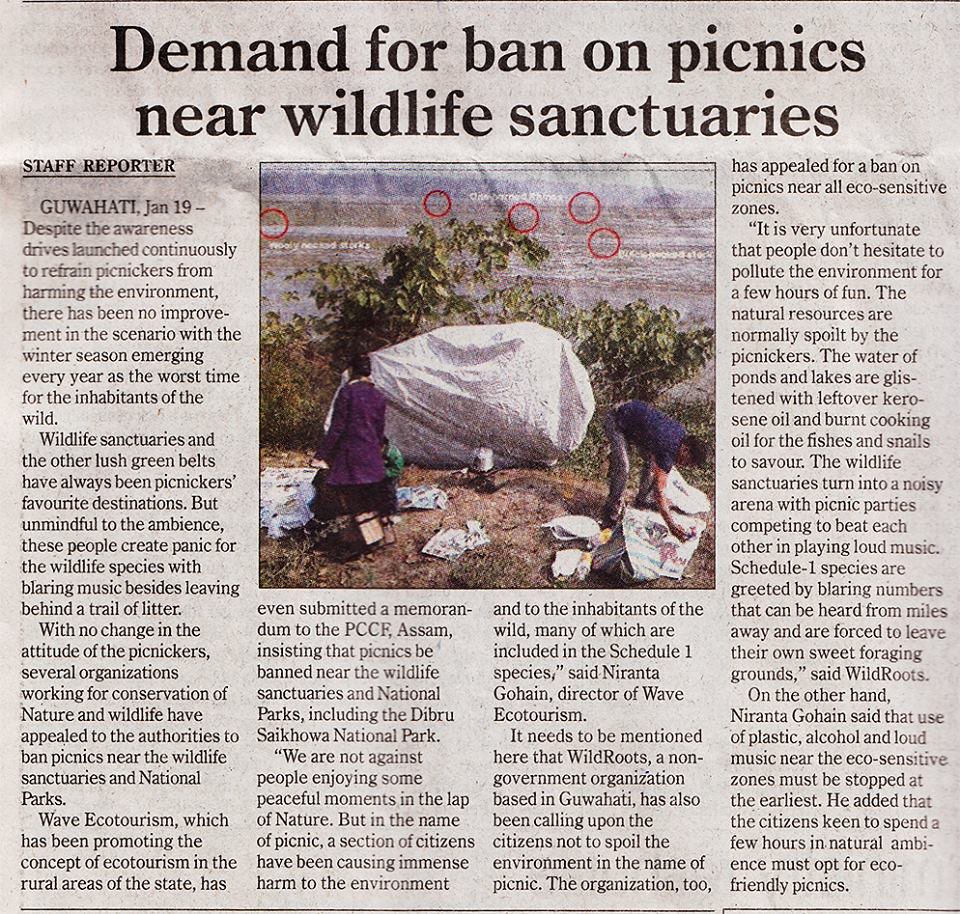
Despite the awareness drives launched continuously to refrain picnickers from harming the environment, there has been no improvement in the scenario with the winter season emerging every year as the worst time for the inhabitants of the wild. Wildlife sanctuaries and the other lush green belts have always been picnickers’ favourite destinations. But unmindful to the ambience, these people create panic for the wildlife species with blaring music besides leaving behind a trail of litter. With no change in the attitude of the picnickers, several organizations working for conservation of Nature and wildlife have appealed to the authorities to ban picnics near the wildlife sanctuaries and National Parks. Wave Ecotourism, which has been promoting the concept of ecotourism in the rural areas of the state, has even submitted a memorandum to the PCCF, Assam, insisting that picnics be banned near the wildlife sanctuaries and National Parks, including the Dibru Saikhowa National Park. “We are not against people enjoying some peaceful moments in the lap of Nature. But in the name of picnic, a section of citizens have been causing immense harm to the environment and to the inhabitants of the wild, many of which are included in the Schedule 1 species,” said Niranta Gohain, director of Wave Ecotourism. It needs to be mentioned here that WildRoots, a non- government organization based in Guwahati, has also been calling upon the citizens not to spoil the environment in the name of picnic. The organization, too, has appealed for a ban on picnics near all eco-sensitive zones. “It is very unfortunate that people don’t hesitate to pollute the environment for a few hours of fun. The natural resources are normally spoilt by the picnickers. The water of ponds and lakes are glistened with leftover kerosene oil and burnt cooking oil for the fishes and snails to savour. The wildlife sanctuaries turn into a noisy arena with picnic parties competing to beat each other in playing loud music. Schedule-1 species are greeted by blaring numbers that can be heard from miles away and are forced to leave their own sweet foraging grounds,” said WildRoots.
Asian Water Bird Count 2016 at IIT, Guwahati yielded less species of Birds than last year. Good sighting of the ‘Tufted Duck’ (Aythya fuligula) and some other water bird species. WildRoots members, with the support of officials from IIT Guwahati had conducted a 3 hour survey within the campus, concentrating on the small and large water bodies.
Observation:
Most of the smaller and medium water bodies of IIT Campus have now been filled up and most of the hills within the campus have been cut for the construction of academic and administrative buildings. Even interaction with the officials has revealed habitat loss within the campus. Can this be the reason of lesser number of Birds this year? Requests have been made to the officials of IIT Guwahati to give a thought on this.
Related Links:
https://www.audubon.org/field-guide/bird/tufted-duck
http://orientalbirdimages.org/search.php?Bird_ID=195
http://sillyreflections.com/2012/02/08/birds-of-iit-guwahati/
Birdwatchers of IIT Guwahati – A Documentary by Avinash Hindupur, Biotech graduate from Indian Institute of Technology, Guwahati, Assam.
https://youtu.be/Y0liSfI0eJc
.jpg)
.jpg)
.jpg)
.jpg)
.jpg)
.jpg)
The event was carried out successfully today at Assam, Meghalaya, Delhi & Mumbai by the senior and junior Birders of WildRoots.
Avian photography was not the focus of today, but a day's survey for the nationwide event yielded some good sightings of common and uncommon birds.
In Guwahati, commendable Birding - Spotting and Photography was done by Subhankar Chakraborty, Siddhant Agarwala & Violina Das. Nimai Biswas had documented the special moments from the event. The day's Bird-Walk yielded about 35 species of Birds. In Delhi, the event was supported by Sutirtha Lahiri, and he has already posted information regarding the same. In Mumbai, the event was supported by WildRoots Content Designer & Poet, Aishwarya Sridhar. She will be sharing some of her words and photographs with us soon.
Thanks to all for making this event..a Grand Success!
Kindly find the Checklist here:
http://ebird.org/ebird/view/checklist?subID=S25853173
.jpg)
.jpg)
.jpg)
.jpg)
.jpg)
.jpg)
Being a member of the IUCN-CEC – Commission on Education and Communication, Mr.Biswajit De had the support from reputed organizations both Nationally & Internationally for all of our Conservation Education Programmes to be undertaken from now onwards. The initial dialogues for a ‘Citizen Science Collaborative Programme’ were initiated during his recent visit to the National Conservation Training Center of the U.S. Fish & Wild Life Service in West Virginia where it was observed that there hasn’t been any collaboration or significant sharing of information regarding the wonderful work that the Institutions of India are doing, for conservation. The present scenario where the entire World is at stir for Climate Change and Environment Awareness, we thought of taking up this initiative and launch this programme, which not only would empower the students with the new generation Conservation Education Paradigms and ICT Tools, but will also give them an opportunity to share information, observation, data, and expressions.
The way we have planned it:
1. It is a project that is entirely supported by WildRoots with some non-monetary help from some of our patrons and friends.
2. We invite Educational Institutions to be a part of it by mobilizing One Teacher Leader, preferably involved with Biology - Botany, Zoology or Geography/Social Sciences and 25 selected students, having different skills and talents. People might ask why we are giving importance to different skills and talent. Well, the Citizen Science Programme is also a wonderful opportunity of expression, where students can express themselves through the deliverables in whichever way they want. They can write, click pictures, draw...collect data, etc.
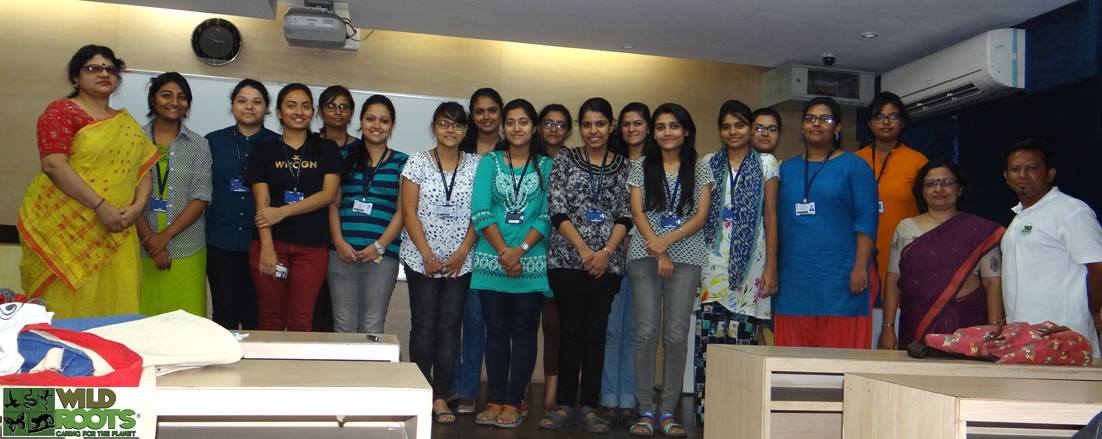
.jpg)
.jpg)
.jpg)
.jpg)
.jpg)
.jpg)
.jpg)
.jpg)
.jpg)
.jpg)
.jpg)
.jpg)
Students of Shri Shikshayatan College, Kolkata share their experiences:

My first survey at Chintamani Kar Bird Sanctuary , Narendrapur, Kolkata , India on 13th Nov'16 was indeed a great experience I had till date. This was my first field work so there were many things to learn and observe. We have learnt to take some good shots , recording data and even practiced to make less noice in jungles so that we don't miss the beautiful view of innumerable birds that comes to this place. We have spotted 24 birds in 6 hours.We have noticed the level of habitat loss due to presence of highway on the right side of the field. Lastly I would like to thank two important people without which this wouldn't be possible. My teacher Dr.Jayati Das and Sir Biswajit De for guiding us throughout. I had the best people to work with. Enjoyed it to every bit.
Thank You!
-Sohini Mutt
Chintamani Kar Bird Sanctuary (Narendrapur,Kolkata).
13.10.2016.
This was my first field work. Firstly i would like to thank my college Shri Shikshayatan and Wild Roots for providing me with this wonderful opportunity. It was a great experience to come in contact with nature and cruise through the various species of birds present here. I came to learn so much of the methods and techniques of a field work . And lastly a big thanks to my fellow team members who were along with me throughout the work Sohini Mutt Stuti Das Anshita Vijayvargiya
-T. Anumita Dayal.
Avian survey at Chintamani Kar Bird Sanctuary, Kolkata, India.
Dated - 13th October, 2016.
This survey was our very first field trip as a part of the "Wild Roots" organisation. And I'm more than glad to say that it went off very well.From taking pictures of some really amazing bird species to knowing about the ecosystem present there, it was an overall wonderful experience. I would like to thank Biswajit Sir for guiding us throughout the trails and telling us about his experiences,which in a huge way have inspired us to work for Our Nature as much as possible. Last but not the least thank you guys, Anumita Dayal Stuti Das Sohini Mutt. You people were really amazing to work with, & we make a good team :) Also, I would like to thank my college Shri Shikshayatan College, Kolkata and my teachers for giving me this opportunity.
-Anshita Vijayvargiya.
CHECKLIST OF BIRDS:
Chintamani Kar Bird Sanctuary, South 24 Parganas, West Bengal, IN
Oct 13, 2016 8:30 AM - 3:30 PM
Protocol: Traveling
2.5 kilometer(s)
Comments: WildRoots - Shri Shikshayatan - T. Anumita Dayal, Sohini Mutt, Anshita Vijayvargiya, Stuti Das, Biswajit De
23 species (+1 other taxa)
Shikra 2 Spotted Dove 3 Lesser Coucal 1 Asian Koel 3 Green Bee-eater 3 Chestnut-headed Bee-eater 2 Lineated Barbet 1 Blue-throated Barbet 2 flameback sp. 2 Greater Flameback 1 Female Alexandrine Parakeet 2 Rose-ringed Parakeet 1 Common Iora 2 Black-hooded Oriole 3 Black Drongo 2 Bronzed Drongo 1 White-throated Fantail 2 Rufous Treepie 2 Red-vented Bulbul 10 Red-whiskered Bulbul 4 Yellow-browed Warbler 1 Common Tailorbird 3 Jungle Babbler 8 Taiga Flycatcher 1
View this checklist online at http://ebird.org/ebird/view/checklist/S32056217
This report was generated automatically by eBird v3 (/content/india)

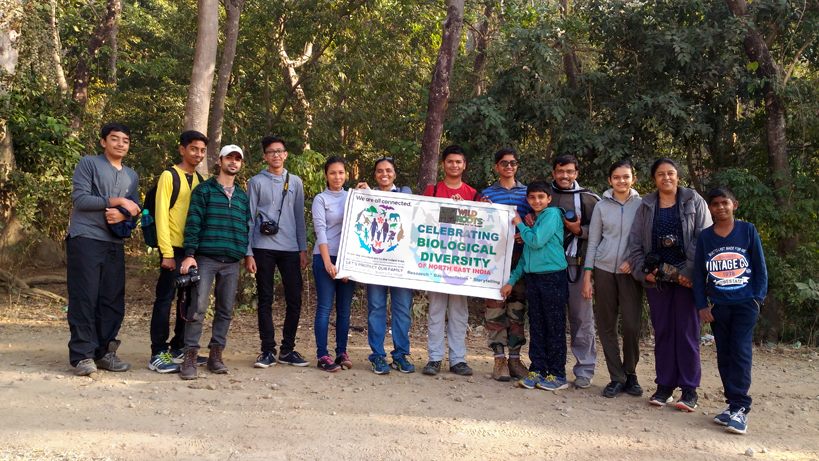
What a way to end the fabulous year 2016 - the year that gave us opportunities to inspire young minds into Conservation.The entire day was spent with Madhusudhan Shukla and his team of students from Bangalore, at the Pabitora WLS, Assam.
.jpg)
.jpg)
.jpg)
.jpg)
.jpg)
.jpg) It was great to have Siddhant Agarwala, Violina Das and Subhankar Chakraborty with us during the day long event. More than 35 species of Birds were spotted and photographed. As usual, the young members of the team were busy in taking GPS reading and use ICT in documenting the spottings.
It was great to have Siddhant Agarwala, Violina Das and Subhankar Chakraborty with us during the day long event. More than 35 species of Birds were spotted and photographed. As usual, the young members of the team were busy in taking GPS reading and use ICT in documenting the spottings.
We will be uploading the inputs and testimonials from 'Team Bangalore'. Though the event was arranged in a hurry, we are glad that our friends from Bangalore had a great time.
Participants of the Programme:
MADHUSUDHAN SHUKLA, ABHEESH.A.BHARADWAJ, LIKITH N MAASTHI, LOLA STUTI, RAHUL NANDISH, ROHITH NARAYAN H S, SHANTHA N, SHISHIR SUDHAMAN, SUMITHRA SINGH H S, VIVEK S,
Thanks to Madhusudhan Shukla of Woody Adventures to come and join us all the way from Bangalore, Karnataka.
Bird Checklist – Enroute and at Pobitora Wildlife sanctuary 31st December 2016
Coordinates 26°14.610” N 92°02.978” Elevation – 180 ft Sl.No. Birds Their action 1. Crested serpent eagle Gliding/foraging 2. Assamese macaque Resting 3. Hoary bellied squirrel Foraging 4. Lineated barbet In flight 5. Grey headed canary flycatcher Foraging 6. Black hooded oriole In flight 7. Asian Pied hornbill In flight 8. Asian open billed stork In flight 9. Spotted dove In flight Coordinates 26°15.998” N 92°01.978”E Elevation – 180 ft 1. Asian pied hornbill Feeding 2. Adjutant stork Feeding 3. Rufous tree pie Resting 4. White breasted kingfisher Resting 5. Indian roller Resting 6. Spotted dove Resting Coordinates 26°14.849” N 92°02.724”E Elevation – 191 ft Sl.No. Birds Their action 1. Green Bee Eater Foraging 2. Black Drongo In flight 3. Pink headed Parakeet In flight 4. Myna Resting and in flight 5. Common glow Kingfisher Resting 6. White breasted waterhen Foraging 7. Pied starling Foraging 8. White breasted kingfisher Resting 9. Open billed stork In flight 10. Chestnut tailed starling Foraging 11. Bronze winged jacana In flight 12. Asian pond heron Foraging 13. Asian open billed stork Foraging Coordinates - 26°14.746” N 92°02.584”E 1. Striated grass bird Foraging 2. Red velvet bulbul Foraging 3. Chestnut headed bee eater Foraging 4. Green bee eater Foraging 5. Asian open billed stork In flight 6. Ruddy shelduck In flight 7. Greater adjutant stork In flight 8. Intermediate egret In flight 9. Cormorant Resting 10. Marsh mongoose Foraging 11. Open billed stork Resting 12. Pin tailed ducks Floating 13. Black headed ibis Foraging 14. Plovers In flight 15. Cattle egret In flight
.jpg)
.jpg)
.jpg)
.jpg)
.jpg)
.jpg)
.jpg)
.jpg)
.jpg)
.jpg)